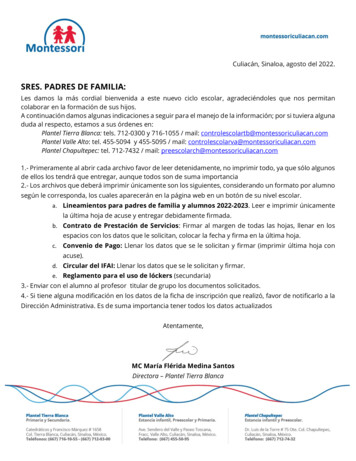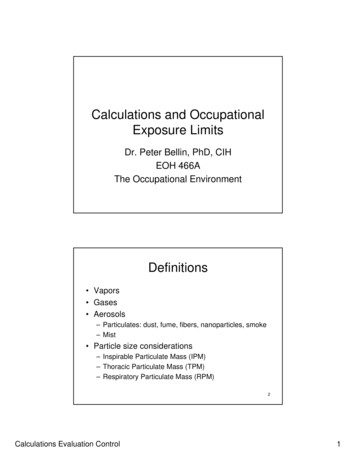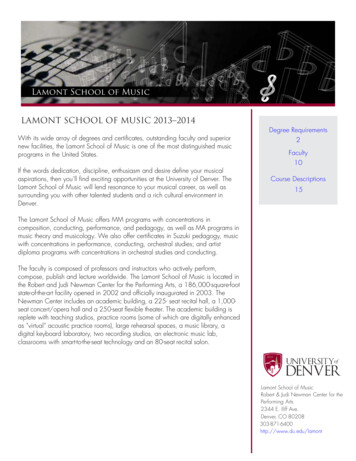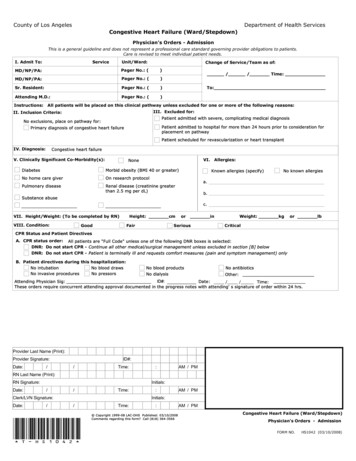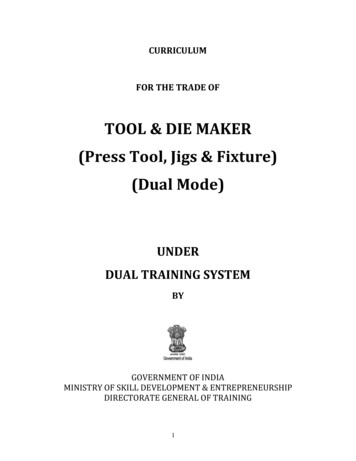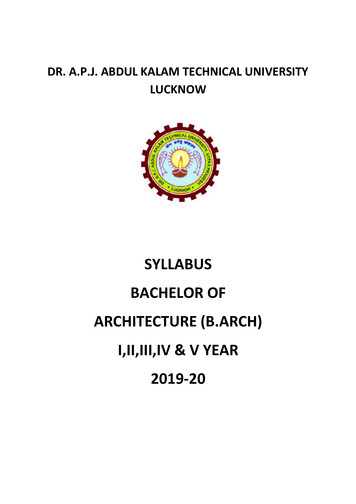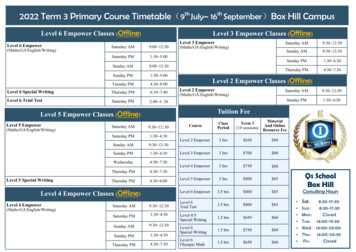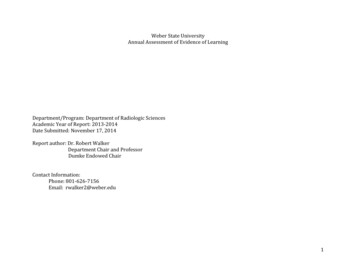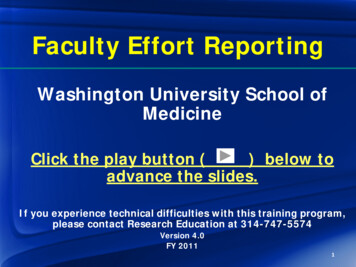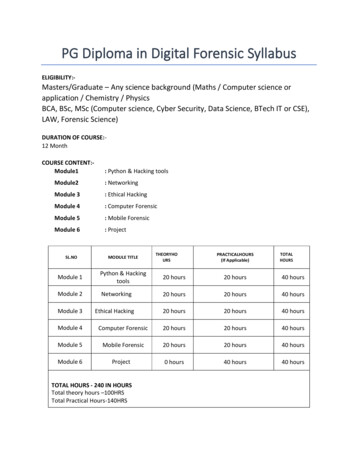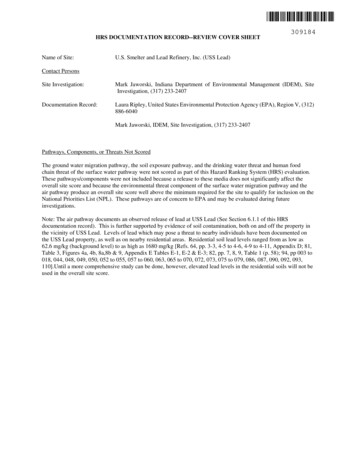
Transcription
*309184*309184HRS DOCUMENTATION RECORD--REVIEW COVER SHEETName of Site:U.S. Smelter and Lead Refinery, Inc. (USS Lead)Contact PersonsSite Investigation:Mark Jaworski, Indiana Department of Environmental Management (IDEM), SiteInvestigation, (317) 233-2407Documentation Record:Laura Ripley, United States Environmental Protection Agency (EPA), Region V, (312)886-6040Mark Jaworski, IDEM, Site Investigation, (317) 233-2407Pathways, Components, or Threats Not ScoredThe ground water migration pathway, the soil exposure pathway, and the drinking water threat and human foodchain threat of the surface water pathway were not scored as part of this Hazard Ranking System (HRS) evaluation.These pathways/components were not included because a release to these media does not significantly affect theoverall site score and because the environmental threat component of the surface water migration pathway and theair pathway produce an overall site score well above the minimum required for the site to qualify for inclusion on theNational Priorities List (NPL). These pathways are of concern to EPA and may be evaluated during futureinvestigations.Note: The air pathway documents an observed release of lead at USS Lead (See Section 6.1.1 of this HRSdocumentation record). This is further supported by evidence of soil contamination, both on and off the property inthe vicinity of USS Lead. Levels of lead which may pose a threat to nearby individuals have been documented onthe USS Lead property, as well as on nearby residential areas. Residential soil lead levels ranged from as low as62.6 mg/kg (background level) to as high as 1680 mg/kg [Refs. 64, pp. 3-3, 4-5 to 4-6, 4-9 to 4-11, Appendix D; 81,Table 3, Figures 4a, 4b, 8a,8b & 9, Appendix E Tables E-1, E-2 & E-3; 82, pp. 7, 8, 9, Table 1 (p. 58); 94, pp 003 to018, 044, 048, 049, 050, 052 to 055, 057 to 060, 063, 065 to 070, 072, 073, 075 to 079, 086, 087, 090, 092, 093,110].Until a more comprehensive study can be done, however, elevated lead levels in the residential soils will not beused in the overall site score.
HRS DOCUMENTATION RECORDName of Site:U.S. Smelter and Lead Refinery, Inc.EPA Identification No.:IND047030226EPA Region:5Street Address of Site:5300 Kennedy Avenue* (Refs. 67, p. 004; 68, p. 1)County/State/Zip Code:Lake County, Indiana, 46312Date Prepared: September 2008General Location in the State: Northwestern Indiana (Refs. 17; 18; 19; 20)Topographic Map:Highland, Indiana Quad (7.5’) (Ref. 18)Latitude:N41o 37'0.33"Longitude: W87o27'50.57" (Ref. 106)Site Reference Point:Approximate center of the source areaCongressional District:01* The street address, coordinates, and contaminant locations presented in this HRS documentation recordidentify the general area the site is located. They represent one or more locations EPA considers to be partof the site based on the screening information EPA used to evaluate the site for NPL listing. EPA listsnational priorities among the known "releases or threatened releases" of hazardous substances; thus, thefocus is on the release, not precisely delineated boundaries. A site is defined as where a hazardoussubstance has been "deposited, stored, placed, or otherwise come to be located." Generally, HRS scoringand the subsequent listing of a release merely represent the initial determination that a certain area mayneed to be addressed under the Comprehensive Environmental Response, Compensation, and Liability Act(CERCLA). Accordingly, EPA contemplates that the preliminary description of facility boundaries at thetime of scoring will be refined as more information is developed as to where the contamination has come tobe located.SITE SCORING SUMMARYPathway Scores:Air PathwayGround Water PathwaySoil Exposure PathwaySurface Water Pathway100.00NSNS60.00HRS SITE SCORE58.311
WORKSHEET FOR COMPUTING HRS SITE SCORES2S1.Ground Water Migration Pathway Score (Sgw)NS2a.Surface Water Overland/Flood Migration Component(from Table 4-1, line 30)60.002b.Ground Water to Surface Water Migration Component(from Table 4-25, line 28)NS2c.Surface Water Migration Pathway Score (Ssw)Enter the larger of lines 2a and 2b as the pathway score.60.003.Soil Exposure Pathway Score (Ss)(from Table 5-1, line 22)NS4.Air Migration Pathway Score (Sa)(from Table 6-1, line 12)100.005.Total of Sgw2 Ssw2 Ss2 Sa26.3600.003600.0010000.0013600.00HRS Site ScoreDivide the value on line 5 by 4 and take the square root258.31
TABLE 4-1SURFACE WATER OVERLAND/FLOOD MIGRATION COMPONENT SCORESHEETMaximum ValueValue AssignedFactor Categories and FactorsDRINKING WATER THREATLikelihood of Release1.Observed Release2.Potential to Release by Overland Flow2a.Containment102b.Runoff252c.Distance to Surface Water252d.3.550Potential to Release by Overland Flow (lines 2a x(2b 2c))550500Potential to Release by Flood3a.Containment (Flood)103b.Flood Frequency503c.Potential to Release by Flood(lines 3a x 3b)5004.Potential to Release(lines 2d 3c, subject to a maximum of 500)5005.Likelihood of Release(higher of lines 1 and 4)5505506.Toxicity/PersistenceaNS7.Hazardous Waste QuantityaNS8.Waste Characteristics100NS50NSWaste CharacteristicsTargets9.Nearest Intake10.Population10a.Level I ConcentrationsbNS10b.Level II ConcentrationsbNS10c.Potential ContaminationbNS10d.Population(lines 10a 10b 10c)bNS11.Resources5NS12.Targets (lines 9 10d 11)bNSFactor Categories and FactorsMaximum ValueDRINKING WATER THREAT (Concluded)Drinking Water Threat Score13.Drinking Water Threat Score((lines 5 x 8 x 12)/82,500, subject to a maximum of 100)100NS550550HUMAN FOOD CHAIN THREATLikelihood of Release14.Likelihood of Release(same value as line 5)3
Waste tionaNS16.Hazardous Waste QuantityaNS17.Waste Characteristics1,000NS50NSLevel I ConcentrationsbNS19b.Level II ConcentrationsbNS19c.Potential Human Food Chain ContaminationbNS19d.Population(lines 19a 19b 19c)bNSbNS100NSTargets18.Food Chain Individual19.Population19a.20.Targets (lines 18 19d)Human Food Chain Threat Score21.Human Food Chain Threat Score((lines 14 x 17 x 20)/82,500, subject to a maximum of100)Factor Categories and FactorsMaximum ValueValue AssignedENVIRONMENTAL THREATLikelihood of Release22.Likelihood of Release(same value as line 5)550550Waste Characteristics23.Ecosystem .Hazardous Waste Quantitya10025.Waste Characteristics1,00032026.Sensitive EnvironmentsTargets27.26a.Level I Concentrationsb026b.Level II Concentrationsb15026c.Potential Contaminationb026d.Sensitive Environments(lines 26a 26b 26c)bTargets (value from 26d)b1506060.00Environmental Threat Score28.Environmental Threat Score((lines 22 x 25 x 27)/82,500, subject to a maximum of 60)SURFACE WATER OVERLAND/FLOOD MIGRATION COMPONENT SCORE FOR A WATERSHED29.Watershed Scorec(lines 13 21 28,subject to a maximum of 100)10060.00SURFACE WATER OVERLAND/FLOOD MIGRATION COMPONENT SCORE30.Component Score (Sof)c,(highest score from line 29 for all watersheds evaluated,subject to a maximum of 100)410060.00
aMaximum value applies to waste characteristics category.Maximum value not applicable.cDo not round to nearest integer.bTable 6-1 --Air Migration Pathway ScoresheetFactor categories and factorsMaximum ValueValue AssignedLikelihood of Release:1. Observed Release5505502. Potential to Release:2a. Gas Potential to Release5002b. Particulate Potential to Release5002c. Potential to Release (higher of lines 2a and 2b)5003. Likelihood of Release (higher of lines 1 and 2c)550550Waste Characteristics:4. Toxicity/Mobility(a)2005. Hazardous Waste Quantity(a)1006. Waste Characteristics10010Targets:7. Nearest Individual50508. Population:8a. Level I Concentrations(b)28108b. Level II Concentrations(b)NA8c. Potential Contamination(c)638d. Population (lines 8a 8b 8c)(b)28739. Resources510. Sensitive Environments:10a. Actual Contamination(c)20010b. Potential Contamination(c)10c. Sensitive Environments (lines 10a 10b)(c)20011. Targets (lines 7 8d 9 10c)(b)3123Air Migration Pathway Score:12. Pathway Score (Sa) [(lines 3 x 6 x 11)/82,500]d100100.00aMaximum value applies to waste characteristics categorybMaximum value not applicablecNo specific maximum value applies to factor. However, pathway score based solely on sensitive environmentsis limited to a maximum of 60.dDo not round to nearest integer5
Aerial view of facility in March of 1986Figure 2-2 Facility Features (as of 1986) (Ref. 65, Figure 2-2)7
Figure 2-3 Source Map (as of 1991) (Ref. 65, Figure 2-3)8
REFERENCESReferenceNumberDescription of the Reference1.EPA, Hazard Ranking System, Final Rule 40 CFR 300, Appendix A, 55 FR 51532,December 14, 1990. 142 pages.2.EPA, Superfund Chemical Data Matrix (SCDM), January 28, /tools/scdm.htm Accessed 02/26/2008. 11pages, excerpt.3.Indiana Stream Pollution Control Board Monthly Monitoring Report for NPDES DischargePermits of U.S.S. Lead Refinery, Inc., East Chicago, Indiana, October, November,December 1986. 9 pages.4.United States District Court for the Northern District of Indiana, Motion of Plaintiff UnitedStates for Partial Summary Judgment, for U.S.S. Lead Refinery, Inc., Civil Action No. H85-0469, October 31, 1985. 36 pages.5.Gnaedinger, Robert J., Field Investigation Report (Final) Concerning Distribution of Lead(Pb) at U.S. Smelting Lead Refining, Inc., Hazardous Waste Investigations Section, EEIBranch of S & A Division – Region V, August 27, 1980. 11 pages.6.Hall, Cynthia, Plan Review and Permit Section, State Board of Health, Indianapolis, Indiana,office memorandum, to U.S.S. Lead Refinery, Inc. RCRA file, EPA ID: IND047030266,July 12, 1985. 2 pages.7.Monteen, Timothy, U.S. Department of the Army, Corps of Engineers, Chicago District,letter, to the Director of the Indiana Stream Pollution Control Board, October 31, 1978. 1page.8.Lamm, David, Solid Waste Management Section, Indiana State Board of Health, letter toTimothy Monteen, U.S. Department of Army Corps of Engineers, Chicago District,November 22, 1978. 1 page.9.Palin, Bruce. Memorandum to U.S.S. Lead Refinery, Inc., East Chicago, Indiana, December27, 1978. 1 page.10.Indiana State Board of Health (ISBH), TSD RCRA Inspection Report U.S.S. Lead Refinery,Inc., EPA ID: IND047030226, September 27, 1985. 20 pages (missing pages 15 and 17).11.EPA, Region V, Environmental Regulatory Review Grand Calumet River and IndianaHarbor Canal, Great Lakes National Program Office, October 1982. 68 pages.12.EPA, Region V, Master Plan for Improving Water Quality in the Grand CalumetRiver/Indiana Harbor Canal, January 1985. 163 pages.13.EPA, Region V, Site Inspection, U.S.S. Lead Refinery, Inc., Central Field InvestigationsSection, Central District Office, Environmental Services Division, January 10, 1984. 5pages.14.Hancock, Daniel F., Vic Windle, and Ed Surla, Fugitive Dust Test Report in the Vicinity ofU.S. S. Lead Refinery, Inc., East Chicago, Indiana, conducted by Emissions SamplingSection (ESS), Air Pollution Control Division (APCD), ISBH, September 16, 1985. 27pages.10
15.Air Pollution Control Division, Field Inspection Report, May 7, 1985. 1 page.16.City of East Chicago, Indiana, Department of Air Quality Control, Routine Inspection Form,August 2, 1984. 2 pages.17.United States Geological Survey (USGS), Calumet City, IL-IN Quadrangle, 7.5 MinutesSeries: 1:24,000. 1998. 1 page.18.USGS, Highland, Indiana Quadrangle, 7.5 Minute Series: 1:24,000. 1998. 1 page.19.USGS, Lake Calumet, IL-IN Quadrangle, 7.5 Minute Series: 1:24,000. 1997. 1 page.20.USGS, Whiting, Indiana Quadrangle, 7.5 Minute Series: 1:24,000. 1998. 1 page.21.Bieze, C.F., Ecology and Environment, Inc. (E & E), memorandum to File, June 13, 1985. 2pages.22.Resource Consultants, Inc., Site Assessment Plan, U.S.S. Lead Refinery, Inc., East Chicago,Indiana, August 3, 1990. 137 pages.23.Mueller, Don, E & E, memorandum to File, EPA, Region V, December 22, 1982. 6 pages.24.Raveed, Dan, Chemical Evaluation Section, Indiana Department of EnvironmentalManagement (IDEM), Interoffice memorandum Review of Laboratory Results for U.S.S.Lead Refining Company, to Michael Sickels, Enforcement Section, IDEM, March 31, 1987.41 pages.25.Hudack, David C., Supervisor, Fish and Wildlife Service, U.S. Department of the Interior,letter to Harry Atkinson, Chief, Site Investigation Section, Office of Solid and HazardousWaste, IDEM, February 24, 1989. 2 pages.26.Warner, Ted, Compliance Monitoring Section, IDEM, memorandum to RCRA file, August1, 1986. 3 pages.27.EPA, Boice, Richard E., Chemical Engineer, EEIB, memorandum RCRA/ISS Inspection ofUSS Lead Refinery, to Rich Shandross, Site Investigation Office, Indiana, WasteManagement Bureau, March 27, 1981. 30 pages.28.EPA, Site Inspection Report, EPA form No. 2070-13, prepared by Curtis Michols,November 25, 1985. 15 pages.29.E & E, Field Investigations of Uncontrolled Hazardous Waste Sites, Sampling Results forU.S.S. Lead Refinery, Inc., May 1982. 9 pages.30.Steels, R.D., Plant Engineer, U.S.S. Lead Refinery, Inc., letter to Jim Hunt, Water PollutionControl Division, ISBH, February 4, 1977. 2 pages.31.Williams, Harry D., Technical Secretary, Division of Land Pollution Control (LPCD), ISBH,memorandum to Air Pollution Control Board (APCB), ISBH, July 2, 1985. 16 pages.32.EPA, Inspection Report of Hammond Lead and U.S.S. Lead Refining Soil Survey,Hammond, Indiana and East Chicago, Indiana, October 15, 1985. 18 pages.33.Warner, Ted, Compliance Monitoring Section, IDEM, memorandum to U.S.S. LeadRefinery, Inc., RCRA File, IND047030226, East Chicago, Indiana, December 21, 1988. 6pages.11
34.Resource Consultants, Inc., Revised Closure Plan, for Baghouse Dust and Calcium SulfateSludge Waste, U.S.S. Lead Refinery, Inc., East Chicago, Indiana, January 17, 1991. 16pages.35.Bidwell, Donald J., Vice President-General Manager, U.S.S. Lead Refinery, Inc., Waste PileClosure Plan, U.S.S. Lead Refinery, Inc., East Chicago, Indiana, August 13, 1982. 5 pages.36.Nygard, Dean, U.S. Lead Refinery, Inc., site photographs, ISBH, September 9, 1977. 20pages.37.Harris Publishing Company, Harris Indiana Industrial Directory, Twinsburg, Ohio, 1986.Excerpt, 9 pages.38.Geochemical Solutions, Final USS Lead Modified RCRA Facility Investigation (MRFI)Report, March 1, 2004. 882 pages.39.Hurt, Oral G., Technical Secretary, Indiana Stream Pollution Control Board, NationalPollutant Discharge Elimination System (NPDES) permit No. IN0032425, June 10, 1975. 1page.40.Schaefer, Robert B., Regional Counsel, and Charles B. Sutfin, Water Division Director,EPA, memorandum to Valdas V. Adamkus, Regional Administrator, EPA, LitigationReport: United States Smelting Lead Refinery, Inc., September 28, 1984. 3 pages.41.Jackson, Wilma, Office Manager, Harbison Walker Refractories, telephone conversation,contacted by Mike Dieckhaus of E & E, July 23, 1991. 1 page.42.Bohr, E. A., Technical Secretary, Indiana Stream Pollution Control Board NPDES permitNo. IN0032425, March 29, 1985. 1 page.43.McGuire, John J., Environmental Engineer, Central District Office, EPA, letter withattachment to Michael Mikulka, Chief of the Compliance Section, EPA, September 28,1990. 3 pages.44.Kovach, Ronald D., Environmental Scientist, Water Division. EPA, Affidavit, United StatesSmelting Lead Refinery, Inc., and attachment, May 12, 1986. 42 pages.45.Dunham, Eric, Assistant Region Counsel, EPA, and Ronald Kovach, EnvironmentalScientist, Water Division, EPA, Litigation Report, U.S.S. Lead Refinery, Inc., andattachment, undated. 134 pages.46.Golubski, Gerald R., Environmental Engineer, Central District Office, EPA, ComplianceSampling Inspection Report, U.S.S. Lead Refinery, March 5, 1985. 27 pages.47.Steiner, Charles, Aquatic Biologist, Central Regional Laboratory, EPA, letter to EdDiDomenico, Water Quality Branch, EPA, January 30, 1984. 2 pages.48.U.S.S. Lead Refinery, Inc., Discharge Monitoring Reports for NPDES Discharge Permits,Indiana Stream Pollution Control Board January, 1984 to April, 1985. 32 pages.49.Jaworski, Mark, IDEM. USS Lead Site HRS – Potentially exposed population for the airpathway, and the distance from USS Lead, August 7, 2008. 2 pages.50.Vick, Rebecca, Bankrupt U.S.S. Lead in East Chicago agrees to pay fine in lawsuitsettlement, “Hammond Times”, Volume B-2, July 4, 1991. 1 page.51.Giammaria, Ann, Secretary, W. R. Grace, East Chicago, Indiana, telephone conversation,contacted by Steve McIntire, IDEM, February 14, 2008. 1 page.12
52.Williamson, Bob, Plant Manager, RESCO Products Inc., Hammond, Indiana, telephoneconversation, contacted by Steve McIntire, IDEM, February 14, 2008. 1 page.53.Haan, Rich, Plant Manager, Universal SVCS, East Chicago, Indiana, telephoneconversation, contacted by Steve McIntire, IDEM, February 12, 2008. 1 page.54.C., Ronnie, Secretary, Calregion Supply Inc., East Chicago, Indiana, telephone conversation,contacted by Steve McIntire, IDEM, February 14, 2008. 1 page.55.Lobewinski, Joe, Sales Department, Pinder Polyurethane & Plastics, East Chicago, Indiana,telephone conversation, contacted by Steve McIntire, IDEM, February 14, 2008. 1 page.56.Plant, Angie, Secretary, Central Rent A Crane Inc., Hammond, Indiana, telephoneconversation, contacted by Steve McIntire, IDEM, February 26, 2008. 1 page.57.Arzon, Chary, Secretary, Meretic Corporation, East Chicago, Indiana, telephoneconversation, contacted by Steve McIntire, IDEM, February 12, 2008. 1 page.58.Ulm, Judy, Secretary, St. Mary’s School, East Chicago, Indiana, telephone conversation,contacted by Steve McIntire, IDEM, February 25, 2008. 1 page.59.Cartagene, Connie, Secretary, Block Junior High School, East Chicago, Indiana, telephoneconversation, contacted by Steve McIntire, IDEM, February 25, 2008. 1 page.60.Jenkins, Kanisha, School City of Hammond Administrative Center, Hammond, Indiana,telephone conversation, contacted by Steve McIntire, IDEM, February 25, 2008. 1 page.61.Donnely, Mrs., Secretary, Edison Elementary School, Hammond, Indiana, telephoneconversation, contacted by Steve McIntire, IDEM, February 25, 2008. 1 page.62.May, Diane, Secretary, St. Catherine of Siena School, Hammond, Indiana, telephoneconversation, contacted by Steve McIntire, IDEM, February 26, 2008. 1 page.63.Vele, Margie, Secretary, West Side Junior High School, East Chicago, Indiana, telephoneconversation, contacted by Steve McIntire, IDEM, February 25, 2008. 1 page.64.IDEM, Expanded Site Inspection, USS Lead, April 2008. 256 pages.65.EPA, HRS Documentation Record for USS Lead, August 30, 1991, 71 pages.66.EPA, Referral of RCRA Subtitle C Corrective Action Facility to CERCLA, June 24, 2004.4 pages.67.IDEM, Adoption of Partial Interim Agreed Order (N-296), IDEM vs USS Lead, April 10,1990. 23 pages.68.EPA, Administrative Order on Consent: In the Matter of: U.S.S. Lead Refinery, Inc.,November 18, 1993. 109 pages.69.IDEM, Mark Jaworski, Telephone conversation with Brian Freeny, EPA, May 22, 2008. 1page.70.EPA, Designation of a Corrective Action Management Unit (CAMU) and InterimStabilization Measures Workplan, November 13, 1996. 22 pages.71.EPA, Design Plan and Specifications for CAMU, July 29, 1998. 2 pages.13
72.USS Lead, USS Lead Refinery Site - Area A Remediation Plan, January 17, 2000. 37 pages.73.IDEM, Area A Remediation Work Plan, February 18, 2000. 3 pages.74.IDEM, USS Lead Wetlands Probable Point of Entry to Lead Concentration Map 2,December 2007. 1 page.75.IDEM, USS Lead Background Sample Location Report, August 3, 2007. 101 pages.76.Arc GIS 9.2 Webhelp Topic, Mapping and visualization, Measuring distances and dex.cfm?tocVisable 0&ID 245&TopicName Measuring%20distances%20and%20areas&pid 240 Accessed 04/02/2008. 2 pages.77.Capiro, Mirtha, EPA, Modified RCRA Facility Investigation (MRFI) Work Plan Addendum,letter to Norman Johnson, July 2, 2003. 3 pages.78.Capiro, Mirtha, EPA, MRFI Report and Interim Stabilization Measures Report, letter toNorman S. Johnson, August 31, 2004. 35 pages.79.EPA, Documentation of Environmental Indicator Determination, RCRA Corrective ActionEnvironmental Indicator (EI) RCRIS code (CA 725) Human Health Exposures UnderControl, September 30, 2004. 10 pages.80.USS Lead, Uniform Hazardous Waste Manifests IND047030226, multiple dates in 1991 and1992. 256 pages.81.Mikulka, Michael J., P.E., EPA, and Capiro, Mirtha, EPA, Report on X-Ray FluorescenceField Study of Selected Properties in Vicinity of Former USS Lead Refinery Facility, EastChicago, Indiana, October 2003. 82 pages.82.EPA, Quality Assurance Project Plan, USS Lead Refinery Inc. and Vicinity, July 2003.Released April 16, 2004. 71 pages.83.EPA, Addendum 1 to Final Report ON X-Ray Fluorescence Field Study of SelectedProperties In Vicinity of Former USS Lead Refinery Facility, East Chicago, Indiana, June14, 2004. 9 pages.84.EPA, Addendum to the Referral of RCRA Subtitle C Corrective Action Facility toCERCLA, September 27, 2006. 7 pages.85.IDEM, Telephone conversations between Steve McIntire (IDEM) and various personnelregarding the number of employees and students at particular addresses in East Chicago,Indiana, February 11, 12, 26, 29, March 4, 2008. 12 pages.86.USGS and US Department of the Interior, Quality of the Grand Calumet River, LakeCounty, Indiana and Cook County, Illinois, October 1984. 174 pages.87.U. S. Department of the Interior, Fish and Wildlife Service, National Wetlands InventoryMap, Highland Quadrangle, November 1981. 1 Page.88.EPA. 40 CFR 230.3 (Definitions), July 1, 2004 Edition. 2 pages.89.Smith, Jim R., Ph.D., IDEM to Jaworski, Mark, IDEM, USS Lead Additional Info, March 5,2008. 4 pages.90.E&E, Telephone conversation between Mike Driskhous (E&E) and Tom Race (Dupont),July 23, 1991. 1 page.14
91.Smith, Jim. R., IDEM Office Memorandum to Jaworski, Mark, IDEM, USS Lead Site, EastChicago, Lake County , Indiana, March, 12, 2008. 95 pages.92.U. S. Department of Agriculture, Soil Conservation Service, Soil Survey of Lake County,Indiana, July 1972. 6 pages, excerpt.93.Federal Register Notice, EPA, 40 CFR Part .htm , February 7, 1992. Accessed March12, 2008. 18 pages.94.EPA, USS Lead (IN) Analytical Data to Jaworski, Mark, IDEM, February 29, 2008. 155pages.95.Metcalfe, Fran, IDEM, Office Memorandum to Jaworski, Mark, IDEM, Evaluation ofESAT’s CLP Data Package Completeness Report, Case #37004, March 14, 2008. 2 pages.96.Strecker, Jacqueline, ISBH, Office Memorandum to McPhail, Warren, ISBH, ProcessMeteorological Data to Assist in the Evaluation of the USS Lead Facility in Hammond,Indiana, August 20, 1985. 6 pages.97.Williams, Harry D., ISBH, Office Memorandum to Strecker, Jacqueline, ISBH, USS LeadRefinery in East Chicago, Indiana, October 21, 1985. 3 pages.98.Harsha, Shri, ISBH, Office Memorandum to Titus, Barry J., ISBH, Lead SIP - FugitiveEmissions, January 30, 1985. 2 pages.99.IDEM, Air Sample Location Map, July 2008, 1 page.100.Department of Air Quality Control, City of East Chicago, Indiana, Routine Inspection Form,August 30. 1 page.101.ScienceDirect, http://www.sciencedirect.com/science? ob ArticleURL& udi B6V784FC3S0W5& user 10& coverDate 06%2F15%2F2005& rdoc 1& fmt & orig search& sort d&view c& acct C000050221& version 1& urlVersion 0& userid 10&md5 2e4b65f5f321ea67f4fc8bddca878f75. Harvard Medical School, Michael B. Rabinowitz, Lead Isotopes inSoils Near Five Historic American Lead Smelters, Received July 20, 2004; acceptedNovember 15, 2004; available online January 29, 2005. 14 pages.102.American Journal of Public Health. Eckel, William P., MS, Rabinowitz, Michael B., PhD,Foster, Gregory D., PhD, Discovering Unrecognized Lead-Smelting Sites by HistoricalMethods, April 2001. 3 pages.103.Collier, Shannon, Rill, & Scott, Attorneys-at-Law, State of Indiana Lead SIP, May 22, 1986.27 pages.104.Collier, Shannon, Rill, & Scott, Attorneys-at-Law, Indiana Lead SIP, June 3, 1986. 18pages.105.IDEM, USS Lead, Wetlands Area within Quarter Mile Radius Map, March 2008. 1 page.106.IDEM, Site Location Map, Arc GIS 9.2, May 2008, 1 page.107.Maupin, Marty, IDEM. Electronic Mail Message to Sickels, Mike et al, IDEM. Field Notesfor USS Lead Sampling, Sample descriptions of SD1 through SD7. November 16, 2007. 2pages.15
108.Sickels, Mike, IDEM. Electronic Mail Message to Mark Jaworski, IDEM. USS Lead SlagPile Surface Water Drainage. May 22, 2008. 1 page.109.Andrews & Kurth, Letter to Mr. Larry G. Reed, EPA. NPL for Uncontrolled HazardousWaste Sites – Proposed Rule No. 12 U.S.S. Lead Refinery, Inc. March 19, 1993. 2 pages.110.IDEM, Office Memorandum from Smith, Jim to Jaworski, Mark. HRS Wetlands near USSLead Site, East Chicago, Lake County, Indiana. May 29, 2008. 2 pages.111.IDEM. Office Memorandum from Smith, Jim to Jaworski, Mark. USS Lead Site HRSSensitive Environment: Habitat Known to be Used by a State Designated Endangered orThreatened Species. June 3, 2008. 2 pages.112.IDEM. Office Memorandum from Smith, Jim to Jaworski, Mark. USS Lead Site HRSParticular Areas, Relatively Small in Size, Important to Maintenance of Unique BioticCommunities. June 3, 2008. 11 pages.113.Jaworski, Mark, IDEM. Electronic Mail Message to Laura Ripley, EPA. Sanborn MapReview. June 9, 2008. 9 pages.114.Jaworski, Mark, IDEM. Electronic Mail Message to Laura Ripley, EPA. Sanborn Maps,Glidden Co. June 10, 2008. 3 pages.115.IDEM. Sample Field Sheets for the USS Lead ESI sampling event, November 2007. 60pages.16
Site SummaryThe U.S. Smelter and Lead Refinery, Inc. (USS Lead) site (CERCLIS ID No. IND047030226) consists ofreleases of lead from sources resulting from facility operations. All operations associated with the facilitywere terminated in December 1985 (Refs. 22, p. 017; 64, p. 11; 65, p. 019; 66, p. 3; 68, p. 5; 81, p. 007; 84, p.003). Prior to cessation of operations, USS Lead consisted of a primary lead smelting and refinery facilityfrom the early 1900s to 1973, and was subsequently converted to a secondary lead refinery, which beganrecovering lead from scrap metal and used automotive batteries (Refs. 22, pp. 007, 014, 016; 45, p. 5; 64, p.11; 65, p. 019; 68, p. 5; 81, p. 1; 84, p. 003).The EPA Superfund program prepared an HRS documentation record for the USS Lead site, dated August 30,1991, as part of the February 7, 1992 proposal to the NPL (Refs. 65; 84, p. 003; 93, pp. 1, 16; 109). A requestwas subsequently made on behalf of USS Lead to defer consideration of the proposed listing of USS Lead(Ref. 109, p. 2).A 39 /- acre wetland, is present on the southern portion of the facility property. This area meets the criteria fora wetland as defined in 40 CFR Section 230.3 (Refs. 1, p. 51625; 91, pp. 3, 4, 6, 7, 8, 49, 51, 53, 55, 57, 59,61, 62, 63; 88; 110). This area is inundated and/or saturated by surface water at frequency and durationsufficient to support, and that under normal circumstances does support, a prevalence of vegetation typicallyadapted for life in saturated soil conditions. This portion of the property contains hydrophytes in both hydricand non-hydric soils (Refs. 88; 91, pp. 47 through 61). National Wetland Inventory Maps published by the U.S. Fish and Wildlife Service indicate that this wetland is designated as freshwater emergent wetland (Ref. 87).This wetland meets the definition of a wetland as defined in 40 CFR 230.3, and is considered eligible as asensitive environment for HRS scoring (Refs. 1, Table 4-24, p. 51625; 87, 88; 110).The southern portion of the facility property, mainly the wetland area, is within a habitat known to be used byState designated endangered or threatened species. The Marsh Wren and Bebb’s Sedge areendangered/threatened species in this area that have been identified within the past five years (Refs. 91, pp. 9,10; 105, 111, p. 1). The Blandings Turtle, another endangered species is also found in this area (Ref. 91, pp.9, 10). The Blandings Turtle and the Franklin Ground Squirrel were last observed in 1999 and 1992respectively (Ref. 91, pp. 9, 10). Also, the wetland area, a particular area, relatively small in size, is importantto the maintenance of unique biotic communities. It is part of the Grand Calumet River Corridor (Refs. 91, pp.3, 4, 6, 7, 8, 18, 24; 112, pp. 1-6).The sources include a slag waste pile and wastewater discharges from an NPDES outfall at the USS Leadfacility resulting from former smelter and lead refining operations (See Sections 2.2 and 2.2.1 of this HRSDocumentation Record). The primary hazardous substance of concern in the sources is lead (See Section 2.2.2of this HRS Documentation Record). A release of lead to the surface water and air pathways has beendocumented (See Sections 4.1.2.1.1, 4.1.4.3.1.2, and 6.1.1 of this HRS Documentation Record). Elevatedlevels of lead have been detected in the wetland area (See Section 4.1.2.1.1 and 4.1.4.3.1.2 of this HRSDocumentation Record).Source 1, a waste pile (lead slag pile), one of the waste sources identified at USS Lead, is an area that waslocated to the south of the plant buildings which was used for disposal of blast furnace slag (Refs. 7; 9; 25, p.1; 27, p. 2; 65, p. 019; 68, p. 7). Between 1980 and 1986, 8 samples of the waste slag material were collectedas part of facility sampling inspections (Refs. 5, p. 4; 24, pp. 8-12, 14, 15, 31; 29, p.4; 68, p. 13). In theanalyses of the seven samples collected in 1986, the slag was shown to contain lead at concentrations rangingfrom 12,000 to 53,000 mg/kg (Refs. 24, pp. 2, 4, 8 to 12, 14, 15, 31). Some of the lead bearing waste wasdeposited directly into part of a wetland, which covers the southern part of the USS Lead property (Refs. 7; 9;25, p. 1; 27, p. 2; 36, pp. 8A, 9, 10, 11, 13, 14; 65, p. 12; 68, p. 7). This is the same wetland as discussedabove. Blast furnace lead bearing slag generated on the facility was dumped on plant property and once a year17
was leveled off into the property wetland (Ref. 9). Overland flow (surface water drainage) came in contactwi
Site Investigation: Mark Jaworski, Indiana Department of Environmental Management (IDEM), Site Investigation, (317) 233-2407 . Documentation Record: Laura Ripley, United States E nvironmental Protection Agency (EPA), Region V, (312) 886-6040 . Mark Jaworski, IDEM, Site Investigation, (317) 233-2407 . Pathways, Components, or Threats Not Scored
